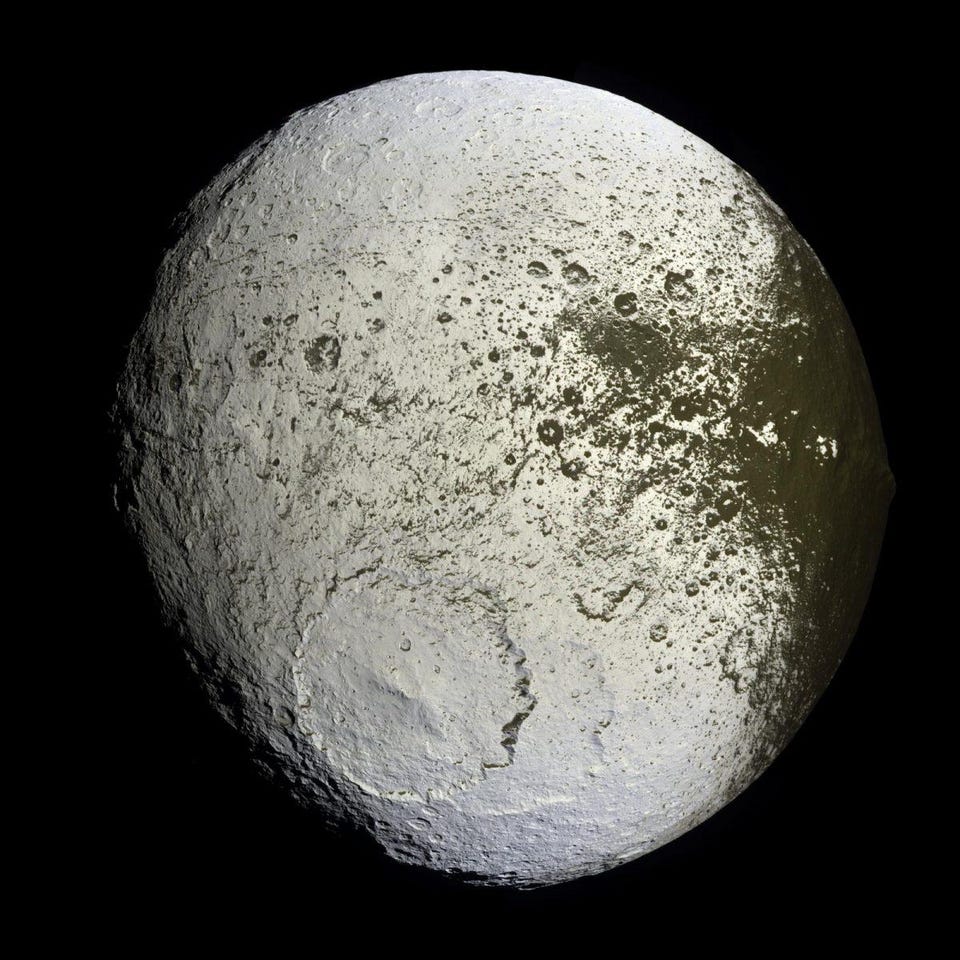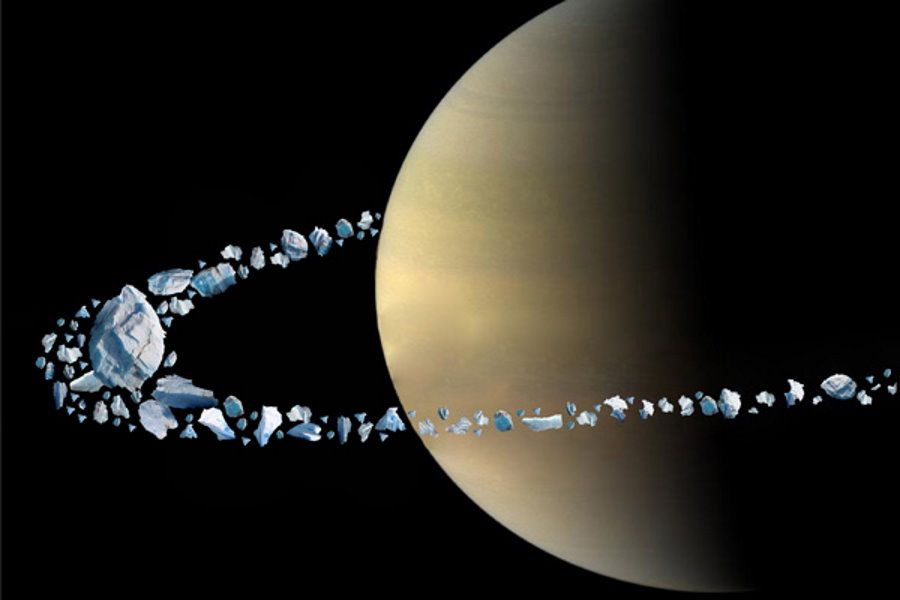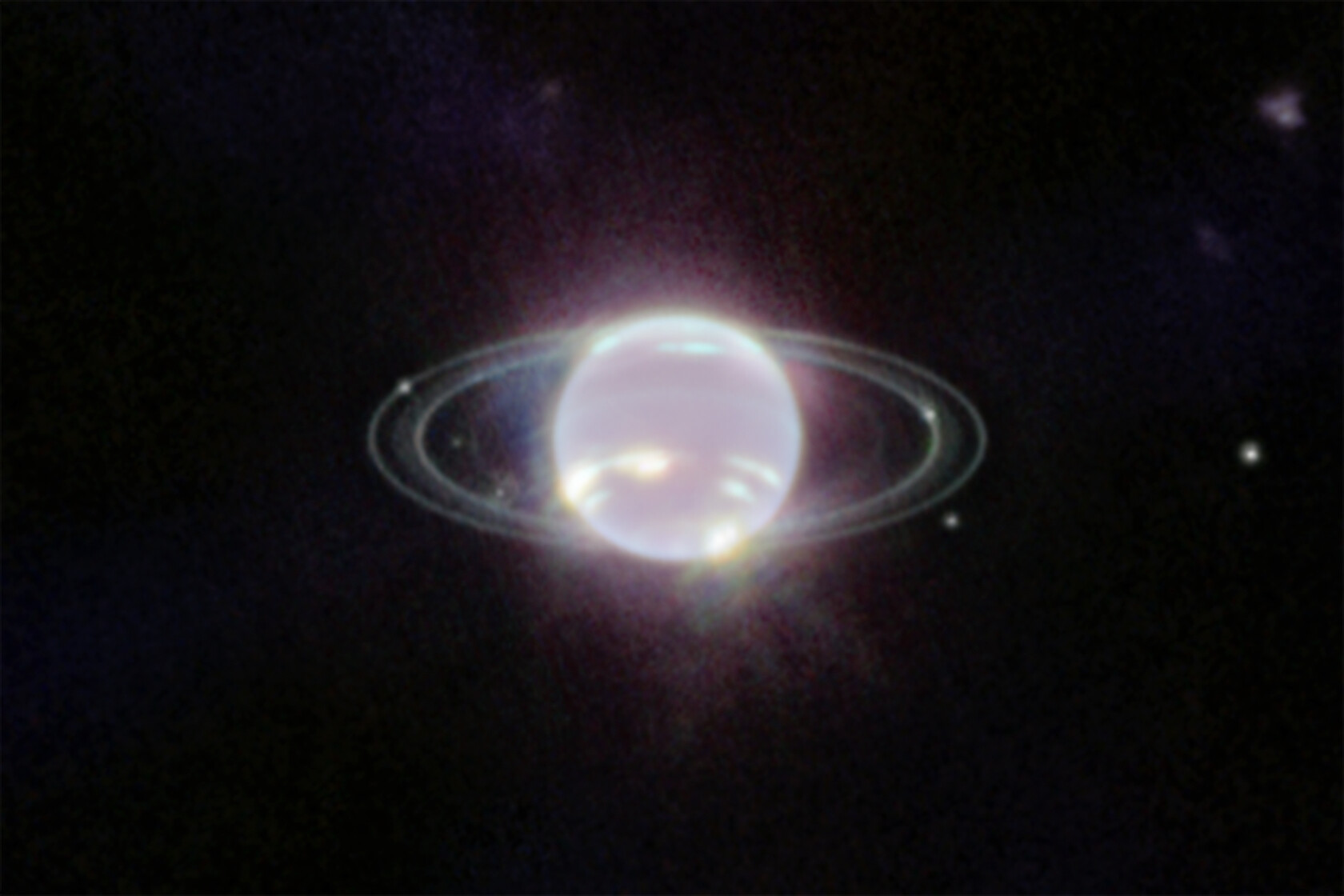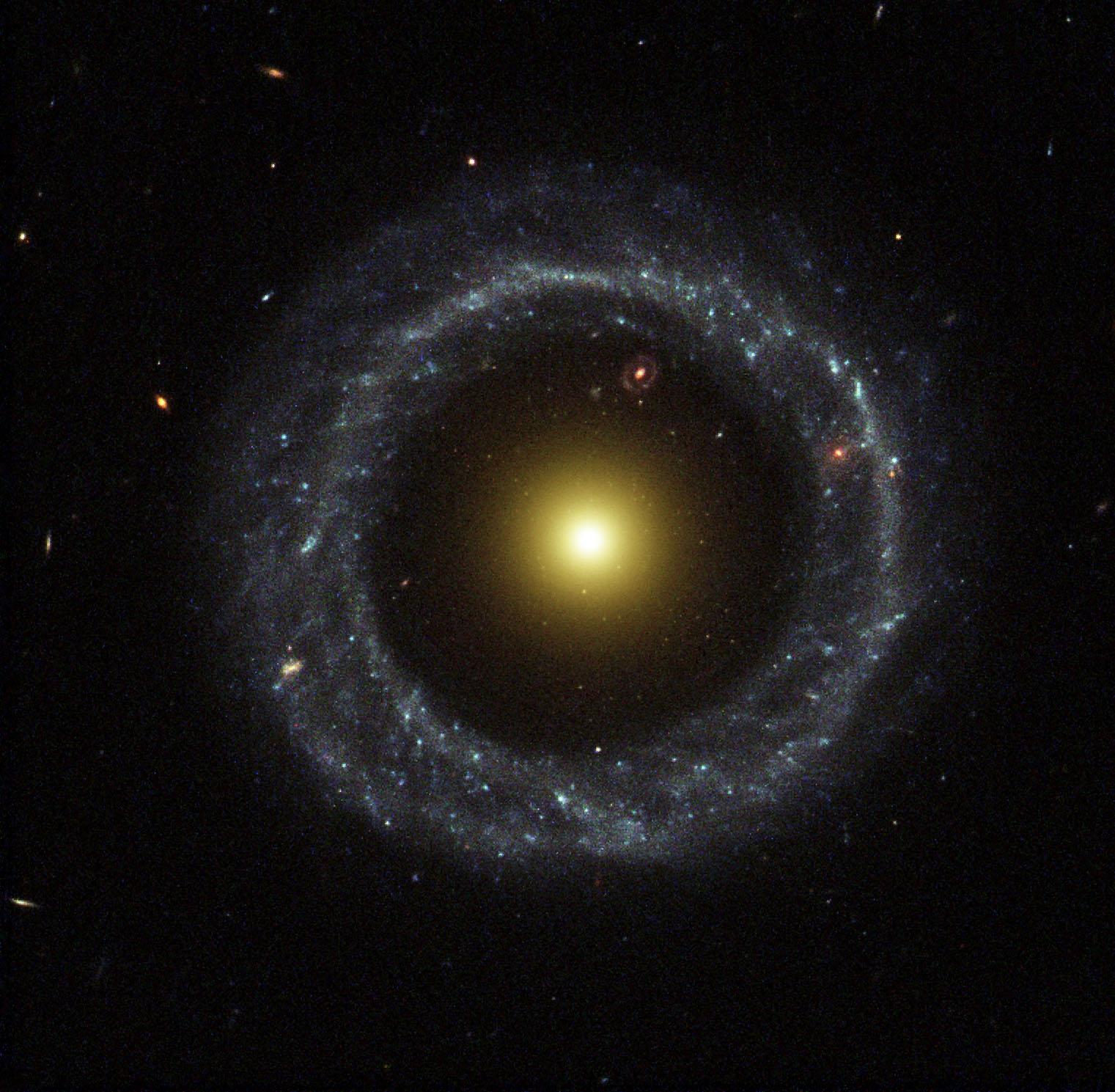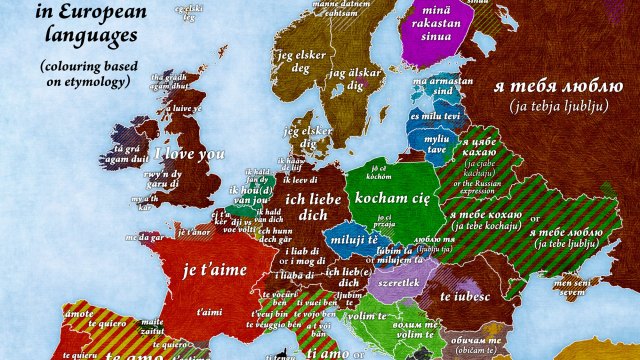The cosmic reason behind planetary rings
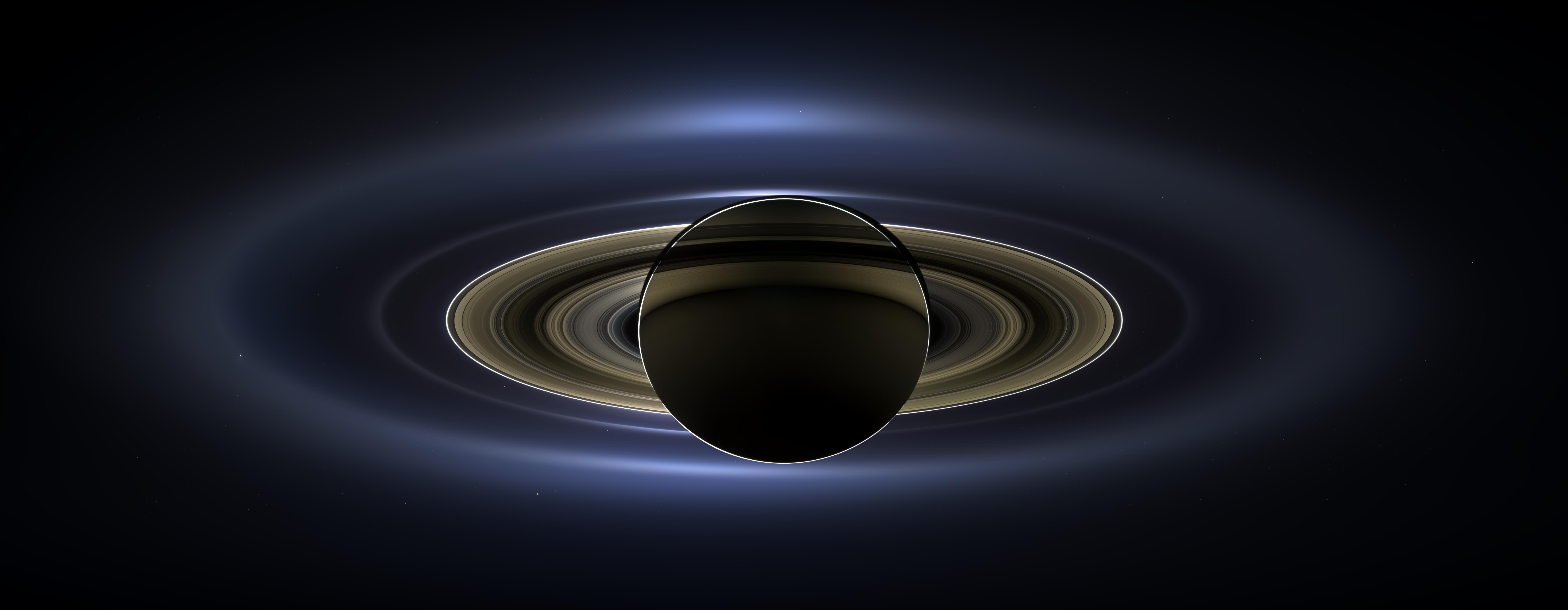
- Although humanity has long been mesmerized by the majesty and grandeur of Saturn’s rings, it turns out that these rings are both new and transient, and that other worlds have them too.
- Jupiter, Uranus, and Neptune all possess substantial ring systems as well, as do a few objects in the outer Solar System: centaur Chiron and Kuiper belt object Quaoar among them.
- A couple of Saturnian moons, Iapetus and Enceladus, also provide hints about the origins and longevity of these ring systems. Cosmic violence might explain it all.
It was more than 400 years ago — all the way back in 1610 — that humanity got our first glimpse of planetary rings. Looking at Saturn through his primitive telescope, Galileo Galilei noted that there were protrusions coming out of both sides of its planetary disk: a feature that he likened to “ears” surrounding it. By mid-century, other astronomers like Christiaan Huygens had gone further and noted a gap separating these protrusions from the planet itself: Saturn was surrounded by a giant ring. In the time since, we’ve discovered gaps, moons, and moonlets within this system of rings, and moreover, that Saturn isn’t the only world to possess them.
We now know that all of our Solar System’s gas giant worlds possess rings: Jupiter, Uranus, and Neptune all have them, but they’re far less significant and massive than Saturn’s rings. We’ve also learned that Saturn’s rings are evaporating, and will likely be no more prominent than Jupiter’s after another 50-200 million years. Additionally, at least two outer Solar System objects — centaur Chiron and Kuiper belt object Quaoar — both possess them, and several known exoplanets show potential evidence for rings.
But what causes rings; where do they come from? As it turns out, cosmic violence in the form of collisions with already-existing satellites might be the explanation behind all of them. Here’s why.
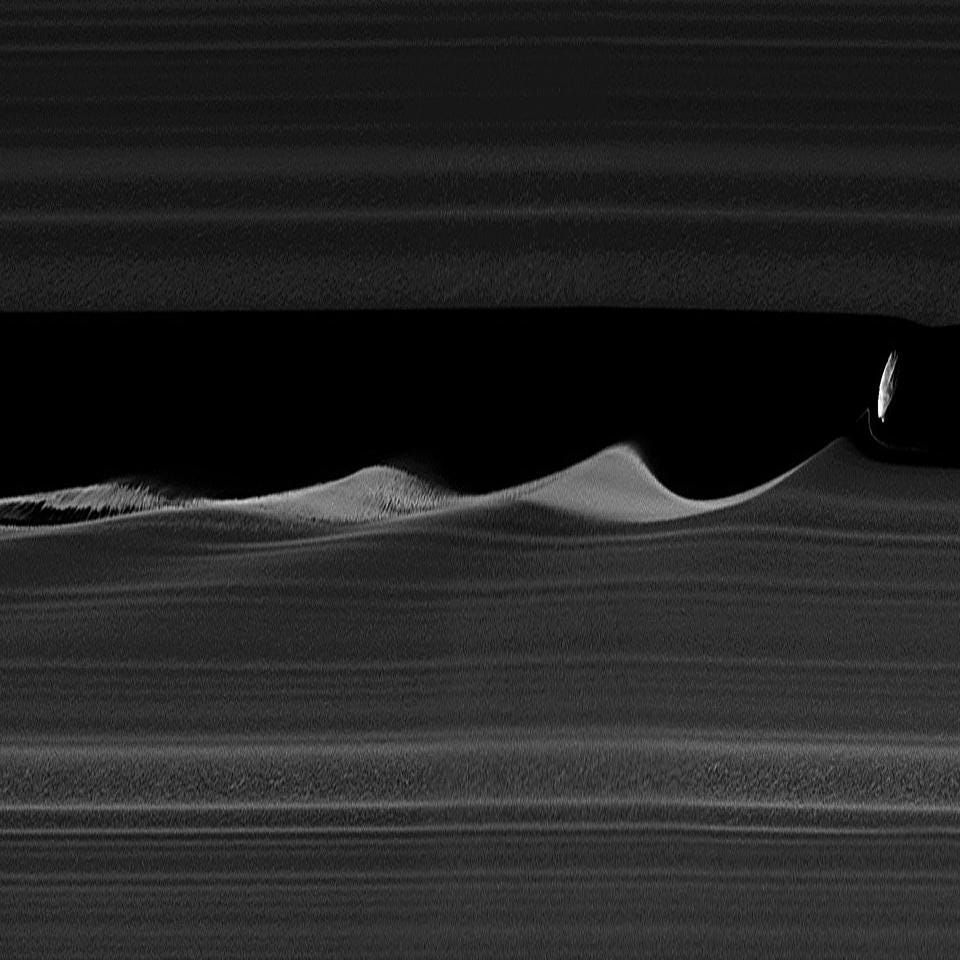
When Saturn’s rings were first spotted, and for many centuries thereafter, astronomers reasonably assumed that there was nothing special about the fact that we were viewing them right now, at this particular moment in time. The rings, at least on human timescales, appeared to be static, implying that they’ve been present for an extremely long time: perhaps as long as the Solar System itself.
However, if we look at this through the lens of modern astronomy and astrophysics, this is no longer the leading explanation for Saturn’s rings. (Although, importantly, it hasn’t been entirely ruled out.) Instead, most scientists now favor a very different scenario: that Saturn’s main rings were formed very recently, within the past ~200 million years and possibly even just a few tens of millions of years ago, by a violent event that destroyed one of its pre-existing moons.
There are a number of strong pieces of evidence that support this particular origin story for Saturn’s main rings, and it’s very important to go through them if we hope to understand the other ringed worlds we presently know of. After all, Quaoar’s recent ring discovery has led to headlines claiming that “These rings are impossible,” but if we place its discovery in the proper context, we can see why such headlines aren’t to be believed.
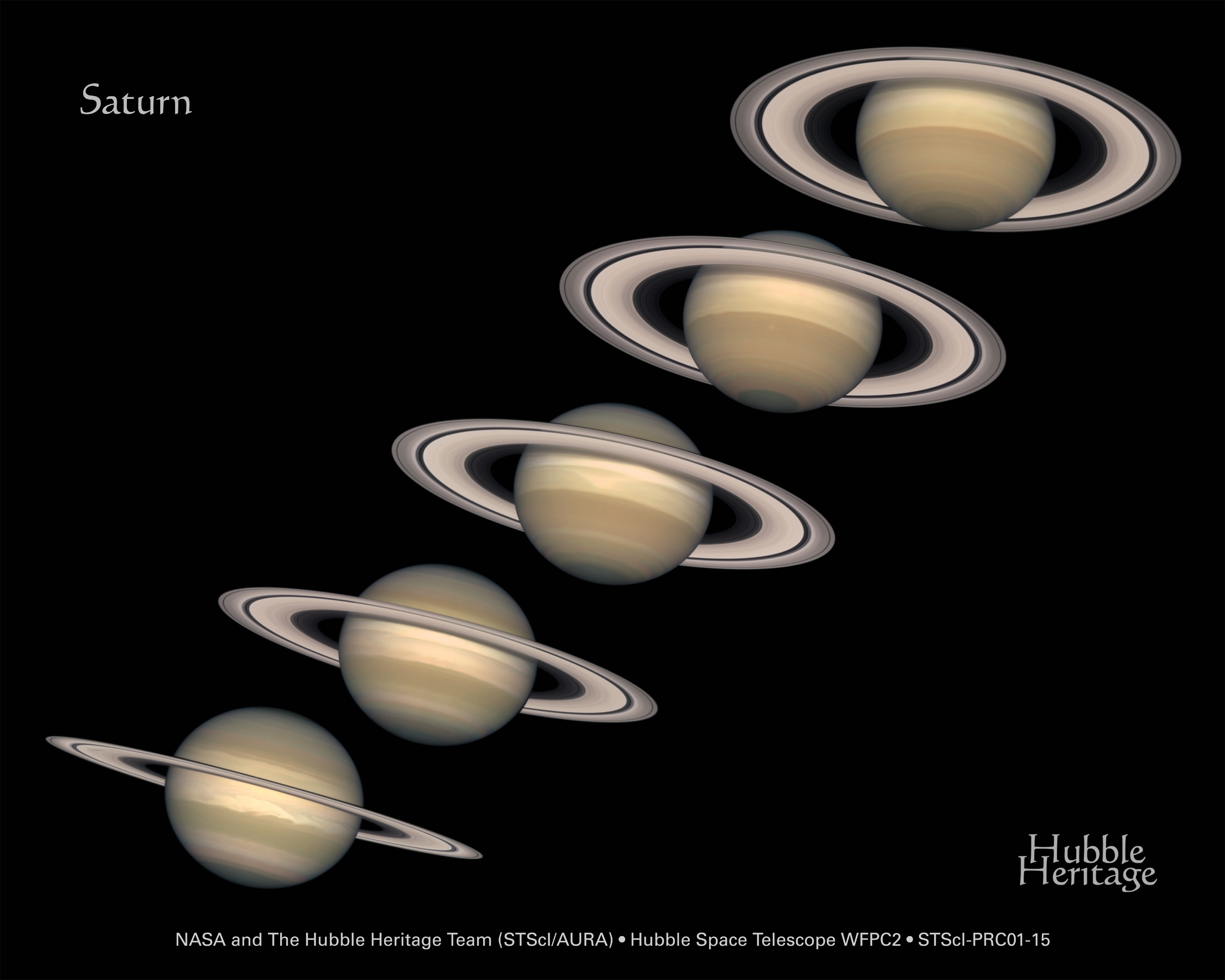
Let’s take a look at some of the similarities and differences between our Solar System’s two largest planets: Jupiter and Saturn.
The planets themselves both rotate relatively rapidly: Jupiter completes a 360° rotation every 9.9 hours, while Saturn completes one every 10.5 hours. However, Saturn’s rotational axis is much more severely inclined than Jupiter’s: 26.73° to 3.13°.
While all of Jupiter’s very massive moons orbit within <1° of Jupiter’s rotation axis, Saturn has exceptions, with Iapetus — its second most-massive moon — orbiting more than 15° out of its rotational plane.
And while Jupiter has a thin system of barely detectable rings in visible light, Saturn’s shine brilliantly and are far greater in both physical extent and in mass. In fact, estimates of the ring mass of both worlds place Saturn’s as over 1000 times as massive as Jupiter’s, and possibly as much as 100,000,000 times as great. Jupiter’s rings are composed mostly of dusty material that seems to match the makeup of some of its nearby moons, but Saturn’s rings are incredibly reflective: composed almost entirely of water-ice.
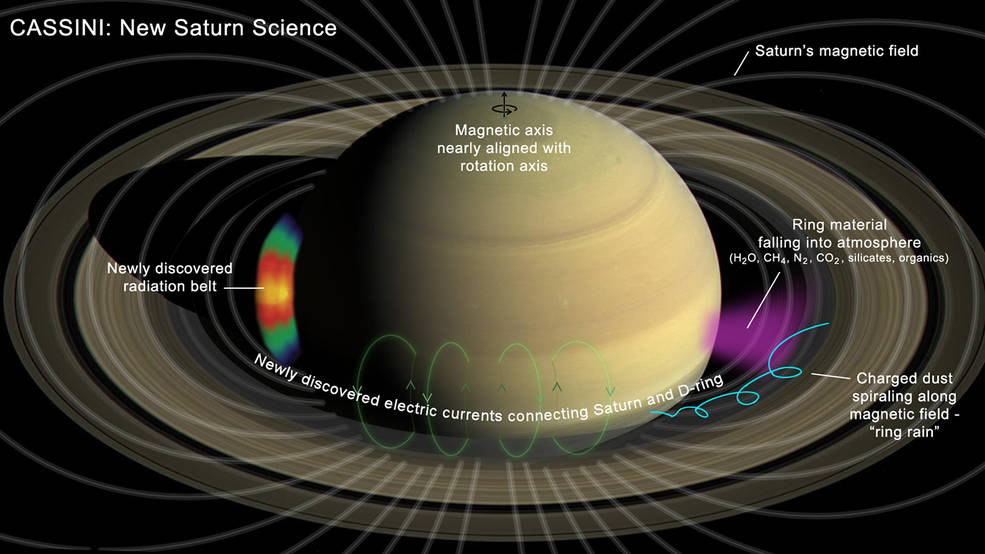
But most alarmingly, Saturn’s rings are now known to be in the process of disappearing rather rapidly. In fact, there are two processes that are both working quite efficiently to help Saturn’s rings evaporate.
- Ionized ring rain: This phenomenon occurs when ultraviolet light from the Sun strikes the water-ice molecules within the rain and can be amplified whenever meteoroid strikes occur, as those strikes create plasma clouds. These reactions excite the molecules and atoms within the rings, creating ions. Saturn’s electrically charged ionosphere interacts with those ions, accelerating and diverting them toward high latitudes around both poles of Saturn. This gives rise to what we know as “ring rain,” and causes the decay of the main rings at all distances from Saturn.
- Equatorial infall of dust and ice: This was discovered toward the end of the Cassini mission, when the space probe passed through the space between the rings and the planet itself. Cassini’s instruments detected that the inner ring particles are actively falling down onto the planet’s equator, including water, methane, nitrogen, carbon dioxide, as well as silicates and organic (carbon-containing) compounds.
By combining the observed rates of these two ring-depleting processes, we can estimate both how long it will take for the remaining rings to decay, as well as how long ago these rings were likely created. The alarming conclusion is that these rings were likely created no more than ~100 million years ago, and will be almost completely gone within the next ~100 million years.
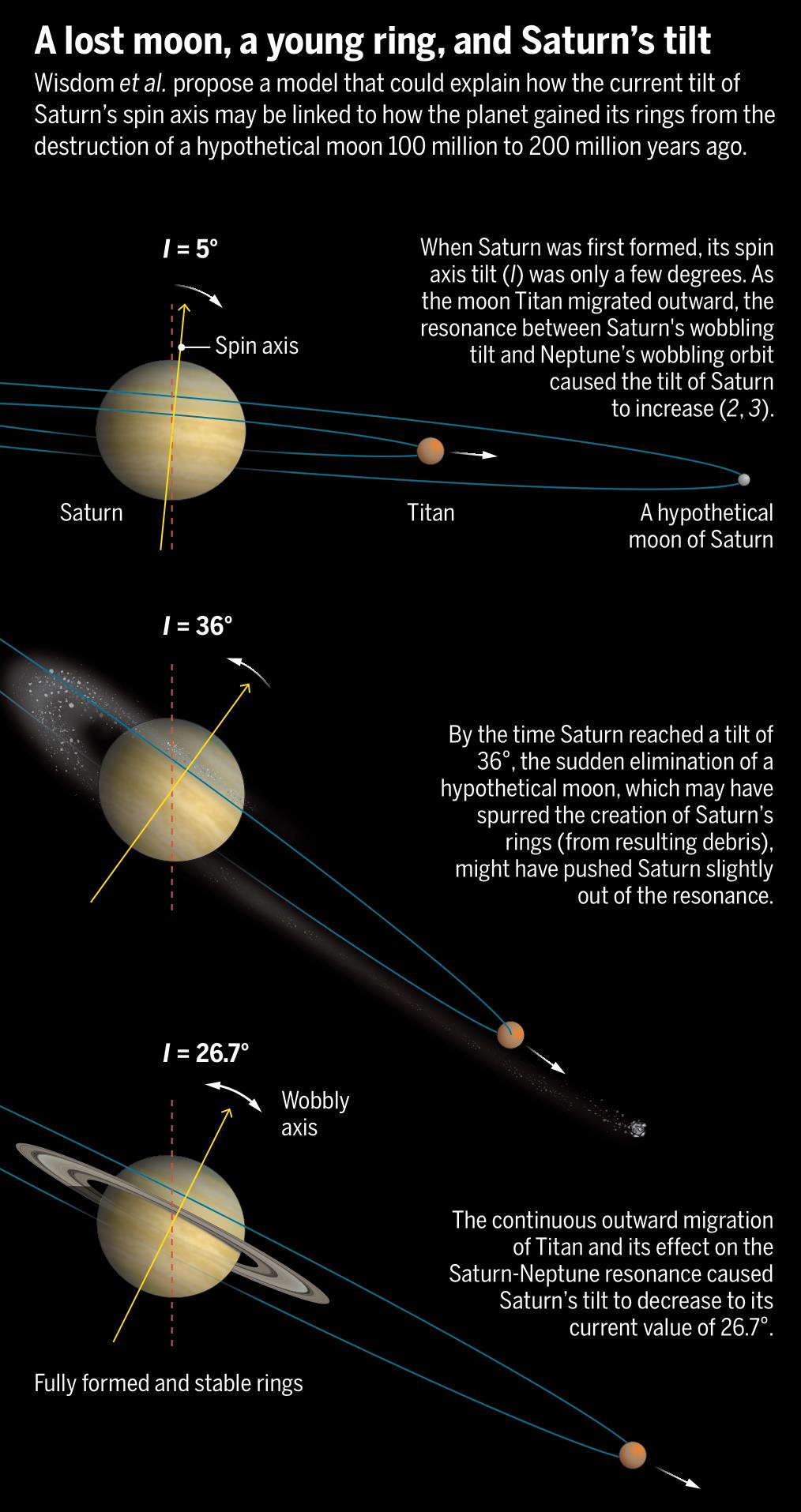
People often wonder why Saturn’s rings haven’t coalesced into a new moon. Similarly, and with a very similar answer, they’ve wondered why the asteroid belt hasn’t coalesced into a single, massive planet as well. The answer has everything to do with three factors:
- the total mass of the rings/debris field,
- the gravitational influences of the other objects in orbit,
- and the stability (or instability) inherent in the small particles that attempt to grow into larger bodies.
With larger amounts of mass, a large gravitationally bound object can easily form. With smaller amounts, however, coalescing into a single object is more difficult. Despite being distributed among thousands upon thousands of massive bodies, the asteroid belt is only about 3% the mass of Earth’s moon, and Saturn’s main rings are only 41% the mass of Mimas, which itself is only Saturn’s 7th largest moon.
And finally, when we look at the interior of Saturn’s rings, we find large numbers of moonlets that carve gaps in the rings, but which don’t last very long before being either ripped apart by the tidal forces of Saturn plus the surrounding bodies, or before they’re struck by a relatively fast-moving particle capable of blowing these moonlets into smithereens, recycling them back into the main ring.

Saturn also has two other rings, both outside of the main rings, of arguably a very different set of origins.
One is the E-ring, which is created by one of Saturn’s more unusual moons: Enceladus. Enceladus is the most reflective moon in the Solar System, made almost entirely out of water-ice. With plumes that erupt from its South Pole primarily composed of saltwater, sand, ammonia, and organic molecules these materials get stretched out in orbit around Saturn, forming an unstable ring that only exists because of its constant replenishment from Enceladus. It suggests that Enceladus might be quite young, and may have even formed in the aftermath of whatever event created the main rings of Saturn.
The second is Saturn’s Phoebe ring, which arises from the moon Phoebe: itself a captured body likely originating from the Kuiper belt. Pumice-like Phoebe is rich in volatiles that get evaporated and boiled off, extending in a large ring-like halo interior and exterior to Phoebe’s orbit. These particles migrate inward due to re-emitting solar radiation, and are responsible for dramatically darkening the leading hemisphere of Saturn’s innermore moon: Iapetus.
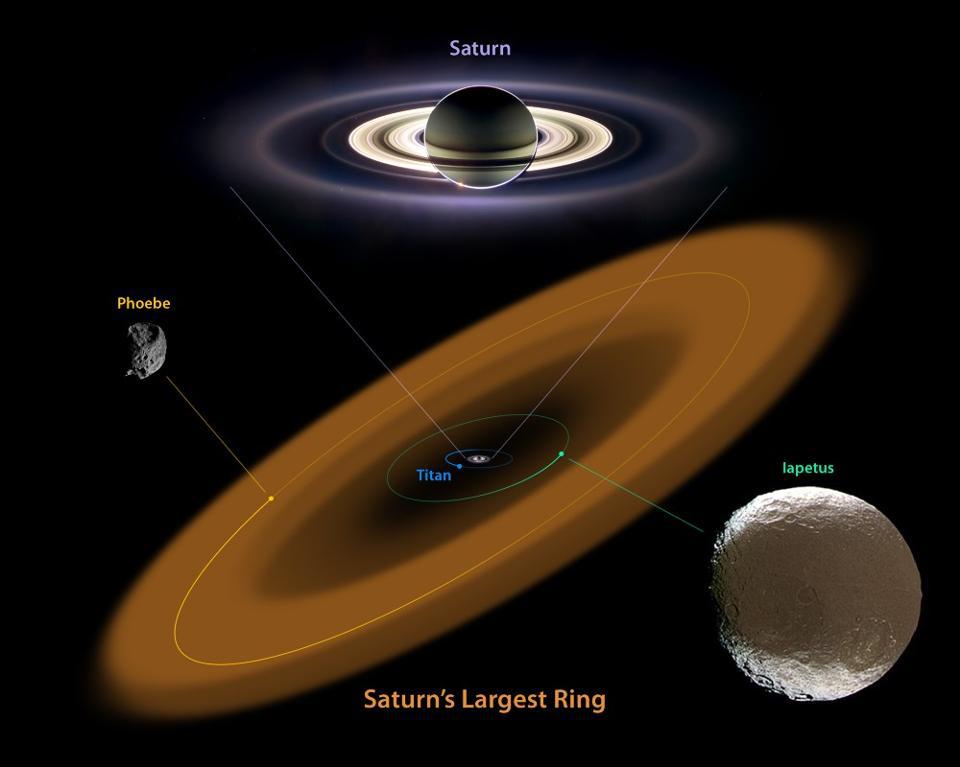
At this point, it’s unknown whether an external body came in and struck a prior moon of Saturn, destroying it with an impact similar to (but larger than) the collisions that created giant craters on Tethys and Mimas, or whether it was destroyed by a passing gravitational interaction that led Saturn to tidally tear the moon apart. However, in either case: Saturn’s rings are relatively young, and won’t last for much longer, at least on cosmic timescales.
It stands to reason that many similar events have happened throughout the Solar System’s history, particularly around the gas giant worlds, with large numbers of moons, a strong gravitational pull, and many opportunities for interlopers to strike a target. From both small and large impacts, it’s easy to imagine that each gas giant world would develop its own system of rings that occasionally become very rich whenever a large disruption of a lunar body occurs.
But there are also known worlds — smaller, rock-and-ice worlds — that actually have rings around them as well. In all known cases, it would have been less surprising to have found orbiting satellites around them, but they were found to have rings instead.
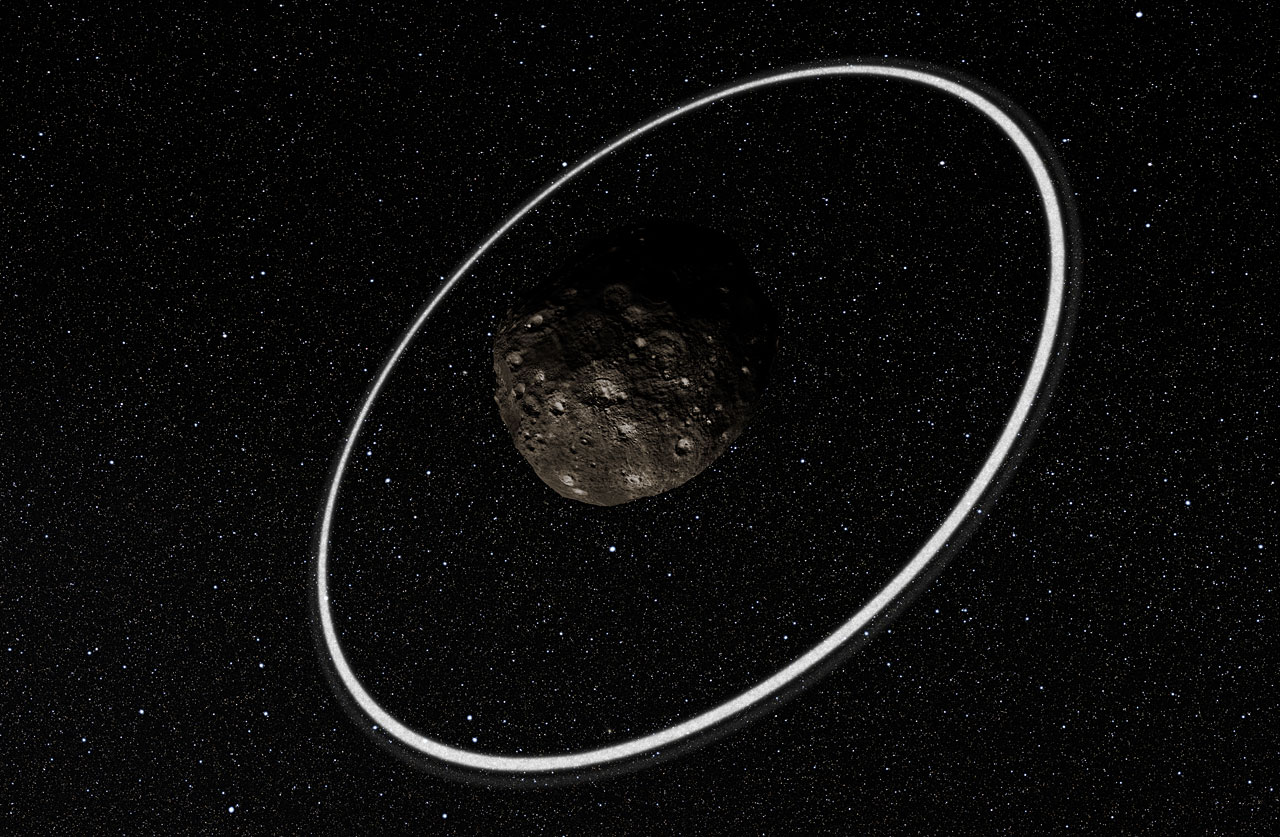
One of them is Chiron: a body that orbits the Sun with a distance that places it between the orbits of Saturn and Uranus. Possessing properties that are somewhere between that of an asteroid and a comet, Chiron was the first of a class of objects found external to Jupiter’s orbit but internal to Neptune’s: the Centaurs. Along with centaur Chariklo, occultations reveal that these objects have rings around them, causing a dimming of background starlight when the rings intervene along the line-of-sight to a star.
There may or may not be moons shepherding these rings, and these rings may or may not be tenuous, sparse remnants of onetime moons that had been destroyed by impacts.
There’s also a gravitational phenomenon that can destroy orbiting bodies and shred them into rings of debris: passing within a massive object’s Roche limit. If a secondary object orbits around a primary object too closely, the tidal forces on the smaller object will tear it apart: first into a ring, and over time, cause it to “infall” and rain down onto the larger body. Haumea, a dwarf planet located in the Kuiper belt, has a ring that falls within this limit, while Saturn’s moon Iapetus has a mid-equatorial ridge: suggestive of a scenario where a body that orbited it — which would be known as a moonmoon — was previously destroyed by tidal forces and caused Iapetus to wind up with a stunning equatorial ridge.
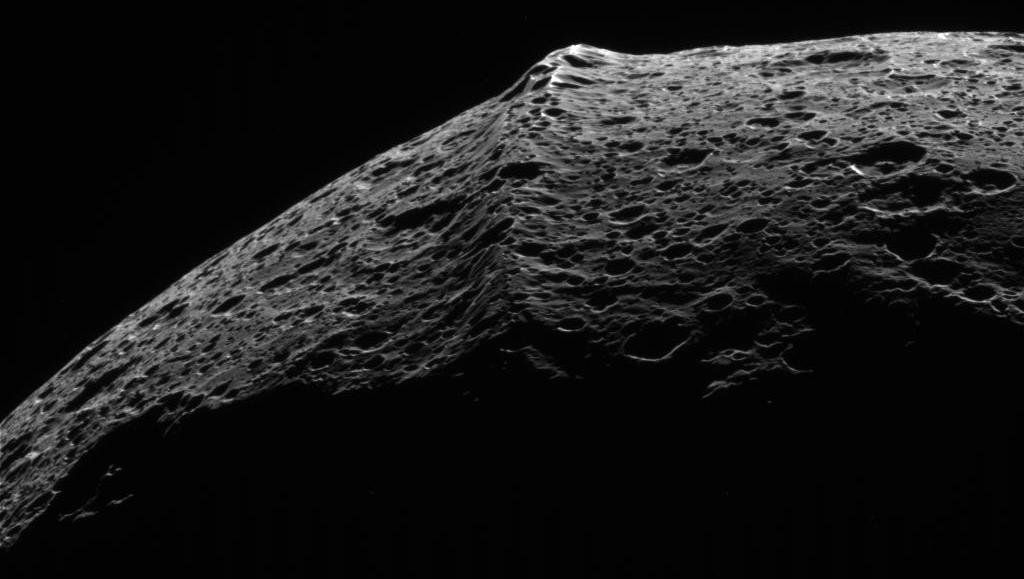
The reason people are getting excited about Quaoar’s ring is that it’s quite distant from its parent body: several times farther away than the Roche limit. And yet, it’s definitely a ring. However it isn’t yet known whether:
- this is a transient ring, created by an impact or other disruption event,
- this ring is stable and shepherded by additional, hitherto undetected moons,
- or whether this ring is being actively generated by some sort of heating/volatile-creating event.
It’s important to remember that among both the asteroids and the Kuiper belt objects, satellites around relatively large and massive bodies are common. The six largest Kuiper belt objects — Eris, Pluto, Gonggong, Makemake, Haumea and Quaoar — all possess satellites, with Quaoar’s rings orbiting well within the orbit of its moon: Weywot. Perhaps surprisingly, Quaoar’s ring varies tremendously in brightness and thickness, suggesting that either, like Enceladus and the E-ring of Saturn, there’s an object that offgasses, creating the rings, or that a set of resonances between the rings and the outer moon (which orbit with a frequency of 6:1) drive its structure, preventing coalescence into a unified moon.
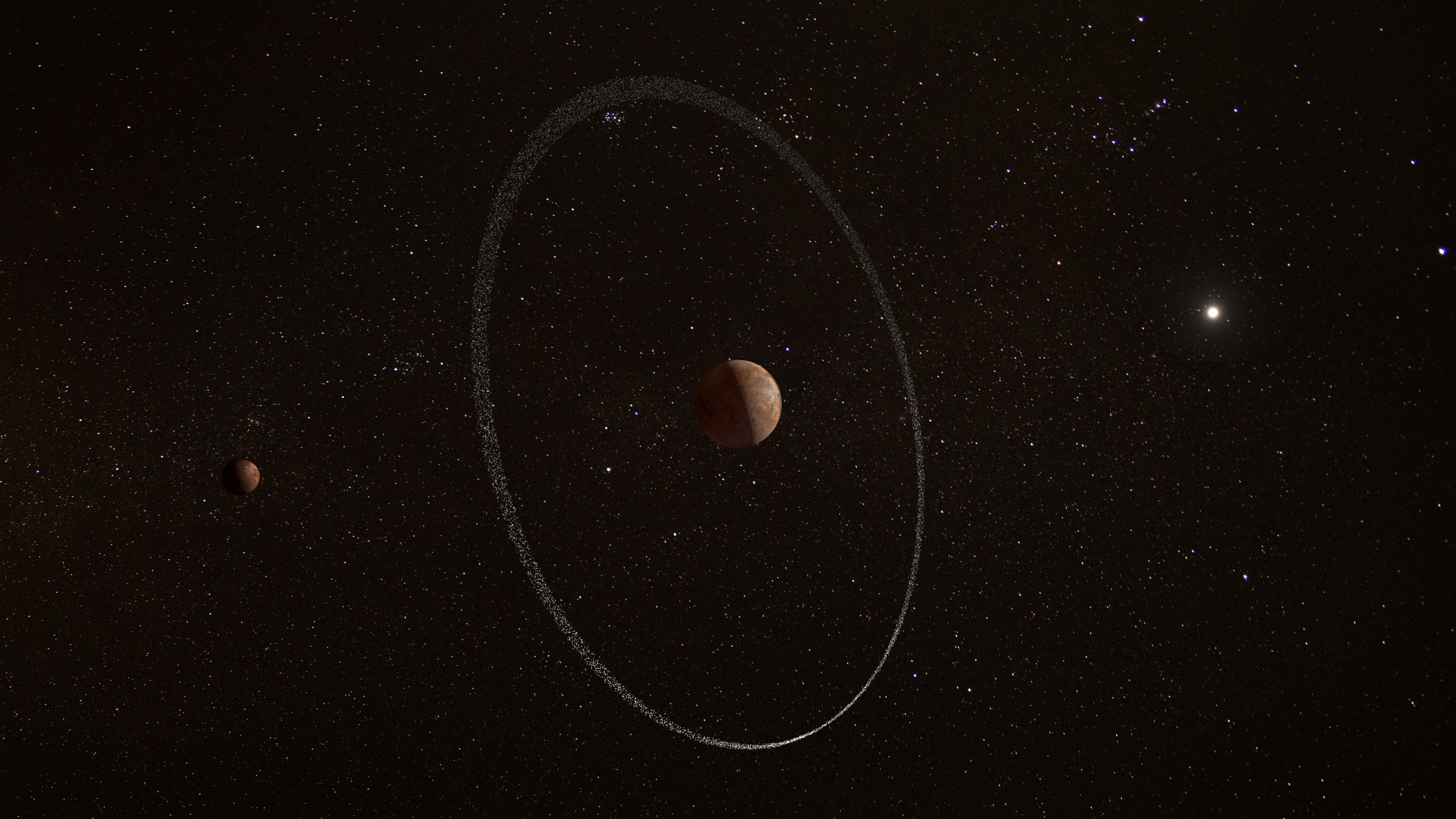
Regardless of which explanation is correct wherever there are uncertainties one thing is clear: there’s one and only one cause for all of the observed ring systems in our Solar System, and that cause is cosmic violence. Sometimes, that violence can be due to external collisions; other times, from the tidal forces from an orbiting parent body; other times, from the gravitational actions of interlopers; and still at other times, from the gravitational and tidal forces of other satellites within the orbital system. Moons can get shredded either all-at-once or little-by-little on an ongoing basis and can give rise to rings and ring systems that can persist for extremely long periods of time.
If humanity could gaze upon our Solar System either a billion years in the past or future, we might discover a system with many differences from what we see at present. Saturn’s rings might be as sparse and flimsy as those presently found around Jupiter. Enceladus and the E-ring might both not exist, as they likely weren’t around 1 billion years ago and might not remain 1 billion years from now. Other giant worlds might have more prominent rings, dependent on their proximity to this type of cosmic violence. And some of today’s satellites might meet their destruction, becoming rings and then having their legacies disappear entirely.
It’s a sober reminder that no matter when we take our snapshot of the Universe, all we can see and access are the survivors. Perhaps our exoplanet studies, when our technology improves sufficiently, will teach us more about the full depth and breadth of ringed systems that exist throughout the Milky Way.
